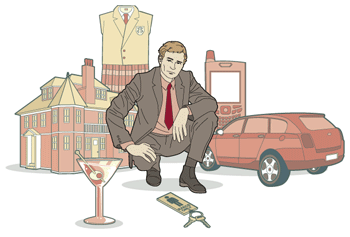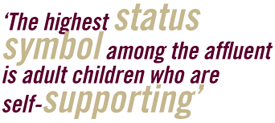MAGIC
MARKERS
Some
things proclaim ‘I belong
to the upper echelons’
By
Kimberley Noble
Need proof that
status-seeking has reached new
heights? Forget Cartier or Palm
Beach mansions or even the fact
that we have all those Internet
billionaires lining up to plunk
down $20 million a pop so they
can play astronaut. I’ve
recently concluded that to see
where things are headed these
heady, acquisitive days, you
need look no further than your
nearest high-end shoe emporium.
Take, for example,
the one in a certain Fifth Avenue
department store built in a
famous mansion adjacent to New
York’s Plaza Hotel. Even
the carriage trade likes a post-Christmas
sale, and this year, when the
cream of Manhattan society came
looking for a good bargain on
Manolo Blahniks, they found
it, providing they were willing
to rummage through piles reminiscent
of a clear-out at the strip
mall.
“There
were piles and piles of shoes,”
recalls an onlooker, who remains
both slightly shocked and vaguely
amused by the spectacle. “And
these were $400, $500, $600
shoes. What does it say about
the world we live in when $600
shoes are sold in piles, like
at Kmart?”
It is a very
good question, but one that
bears looking at from the other
point of view. For the better
part of a decade, women of substance
and taste could show that they
belonged to one of humanity’s
upper echelons simply by wearing
shoes that have come to be known
by the first name of their Spanish-born
creator. Sociologists call them
markers: garments, adornments
or modes of dress enlisted by
human beings to signal membership
in a desirable group.
Markers of
status have been around ever
since some clever primate first
decided to wear an especially
large set of sharp teeth around
his neck as a sign of hunting
prowess, and to urge his mate
to go ahead and wear the animal’s
impressive fur on a reasonably
warm day—and found that
hunters and gatherers in their
chosen circle decided to do
the same.
“We want
to be identified with the most
powerful,” says University
of Toronto sociologist Elijah
Dann, the source of the pricey
footwear story. “We want
to associate with the person
with the biggest clubs, who
can kill the most game and acquire
the most goods. If we are part
of their tribe, we will be taken
care of and kept safe.”
| |
 |
| |
Status markers
lose their power, however, when
everybody, including other less
successful tribes, do the same,
i.e., when Manolos become so
popular and plentiful that the
world’s best shoe emporiums
start selling them practically
by the pound. To a certain extent,
we can blame Sex and the City’s
Carrie Bradshaw and other pop-culture
trend-setters, both fictional
and real, who can, almost overnight,
create a groundswell of demand
for what were once exclusive
badges of wealth and taste.
But this can also be attributed
to sheer economic growth. “There
is such a huge amount of money
out there, in the hands of people
who are searching for new ways
to spend it,” says Glenn
Pushelberg, whose ultra-chic
Toronto design firm, Yabu Pushelberg,
counts many of these people
among its clients. “There
are many, many minor millionaires,
compared with 20 years ago.
Everybody has a Rolex watch,
a Louis Vuitton purse.”
This, he says, begs the question:
What do you do when all of the
luxury goods are available to
the masses?
The solution,
as always, is found in identifying
and acquiring markers of status
that are even more exclusive.
Bigger. Better. More expensive.
Harder to get hold of or, in
the case of neighbourhoods and
schools, to get into. (For the
latest and most entertaining
examples, see the following
pages.) That said, just like
everything else in our fast-paced
modern world, it appears that
status-seeking behaviour has
been forced to adapt to changing
circumstances.
In the past—or
at least in the century or so
since the pursuit of status
became a recognized subject
of academic research, and a
rebellious American economist
named Thorstein Veblen came
up with the term “conspicuous
consumption”—status
seekers could always rely on
some showy display of worldly
goods to signal their good fortune.
Now that such goods are no longer
a reliable indicator, the trends
seem to point in three directions.
First, there
are the handcrafted, handmade,
one-of-a-kind items. “That’s
what the real billionaires look
for, because there are so few
things left in the world that
are unique, exclusive to one
person,” Pushelberg says.
For example, the solution to
one’s footwear dilemma
can now be found at Rickard
Shah, a London-based fashion
designer that uses a new 3-D,
high-tech body-scanning device
to design and make custom shoes
for its (literally) well-heeled
clients. Feet are scanned in
the Belgravia boutique, and
the specifications sent to Florence
where the leather is cut and
assembled by world-renowned
cobblers. Even better is the
cost, which ranges from $625
to $800 US, including the scan.
Vogue magazine has declared
this custom footwear to be far
superior to those tacky see-through
jobs that Cinderella’s
godmother threw together for
that ball.
At the extreme
other end of the custom-made
spectrum, one finds the 400-plus-foot
mega-yachts belonging to Saudi
billionaires and their North
American counterparts—software
sheiks, like Microsoft’s
Paul Allen and Oracle’s
Larry Ellison. These floating
mansions—many of them
designed and crafted by shipbuilder-to-the-aristocracy
Lürssen at its top-secret
super-yacht factory on Germany’s
Weser River—have in recent
years been cited as the ultimate
status symbol among the world’s
super-rich.
Clearly, the
very existence of such boats,
which can cost upwards of $200
million and measure more than
170 metres in length, is remarkable,
actually spawning a media subculture
that does nothing but track
and report on the progress of
their construction.
 |
|
Illustration
by Kagan Mcleod |
I find this
sort of old-fashioned conspicuous
consumption reassuring, like
the Tiffany salesman in the
Audrey Hepburn film who says
that knowing you can still get
prizes in Cracker Jack gives
him a “feeling of solidarity,
almost of continuity into the
past.” This provides a
link, not only with the past
but also with nature. It means
that underneath all that alpha
male posturing, software billionaires
might not be all that different
from another of the planet’s
oddly compelling creatures—the
tropical bower bird, which,
in addition to its iridescent
plumage, constructs elaborate
structures, known as bowers,
out of twigs, leaves, moss and
whatever colourful materials
it can find, not as nests but
as flashy bachelor pads to display
status and—the bower bird
hopes—attract the maximum
number of willing mates.
However timeless
this behaviour, mega-yachts
are even more interesting for
what they say about the changing
nature of social and business
status. Unlike a personal jet,
the ultimate status symbol of
the 1990s, a boat the size of
a cricket ground does not tend
to be used for business as well
as pleasure. It does not say
that its owner is a busy guy
whose day is packed with far-flung
business meetings. Instead,
a mega-yacht says that its owner
has made his fortune and is
now in possession of what have
become the most valuable of
human commodities: well-earned
and enormously expensive leisure,
and vast expanses of personal
space.
Because while
mega-yachts would seem to be
pretty tangible proof that Veblen’s
theory of conspicuous consumption
is alive and well and living
in the 21st century, they also
convey a sense of having limitless
space in a crowded world—a
concept that points to another
trend, which I will call non-conspicuous
consumption.
Have you noticed
how the Victorian notion that
wealth was represented by rooms
crammed with furniture and personal
bric-a-brac has made way in
modern times for the extreme
opposite? How these days, only
the worker bees inhabit the
same rooms as their possessions,
whereas the successful can afford
to store their possessions out
of sight and live in cavernous
rooms containing nothing but
a couple of leather chairs and
a kick-ass entertainment system?
In his new
book, Don’t Get Too Comfortable,
Canadian expat GQ columnist
David Rakoff takes this even
further. He describes how the
greedy ’80s gave way to
the “even greedier ’90s,
when money flowed like water
and everybody’s boat rose
with the tide” and documents
the process by which, when consumer
goods and other traditional
status symbols lose their power,
status-seeking humans react
by fetishizing the basic commodities
of human existence. Rakoff’s
favourite examples are Scottish
ice cubes and French sea salt,
which in turn become absurdly
expensive luxury items. In a
chapter entitled “What
is the Sound of One Hand Shopping?”
he writes: “We have become
an army of multiply chemically
sensitive, high-maintenance
princesses trying to make our
way through a world of irksome
peas.”
| |
 |
| |
While this
is certainly true of the specific
tribe that Rakoff makes his
living from by observing them—young,
wealthy, status-seeking cosmopolitans—sociologists
contend that other tribes display
different behaviours. No description
of contemporary status symbols
would be complete without noting
that status depends not only
on the traditional factors—financial,
social and cultural capital—but
also on age. “You get
both class and generational
differences,” says Douglas
Mann, who teaches sociology
and philosophy at the University
of Western Ontario, in London,
Ont., citing the fact that a
big, luxurious SUV would mean
nothing to most of his students,
whereas “the latest MP3
player in a pink case”
would be equally meaningless
to older people. “So,
the way you display and detect
status,” he explains,
“changes throughout your
life.”
With that concept
in mind, one Bay Street anthropologist
identified a third major trend
when it comes to what Canada’s
richest and most powerful consider
the ultimate display of status:
gainfully employed offspring.
“There is so much pressure
among the upper classes to work
hard, be successful, make money,
live in the big houses, have
the right holidays, the whole
rat race. Along the way, there’s
mini-status if your kids get
into the right schools; there’s
mini-status if they get good
marks; there’s mini-status
if they get into a good university
and maybe go to grad school.
“But
after all that, what people
are worried about is that after
all this they’ve maybe
spoiled their kids, that there
will be something wrong with
them and the kid will never
work and you will support them
forever.” He says he’s
not kidding. This is a huge
preoccupation, even among people
who have everything else. “The
highest status symbol among
the affluent class is adult
children who are self-supporting.”
Finally, it
seems that for the ultimate
tribal leaders—the old-moneyed
billionaires that the subservient
status-seekers spend their lives
trying to emulate—the
ultimate symbols of status turn
out to be nothing at all. “The
new money wants the American
Dream,” says Pushelberg.
“The big money stays hidden,
especially in Canada.”
In his experience, the only
thing people with top status
want are their basic simple
comforts, their family and friends,
and privacy. “People who
have truly large amounts of
wealth know who they are,”
he says, “and they don’t
need anything else.” 
|